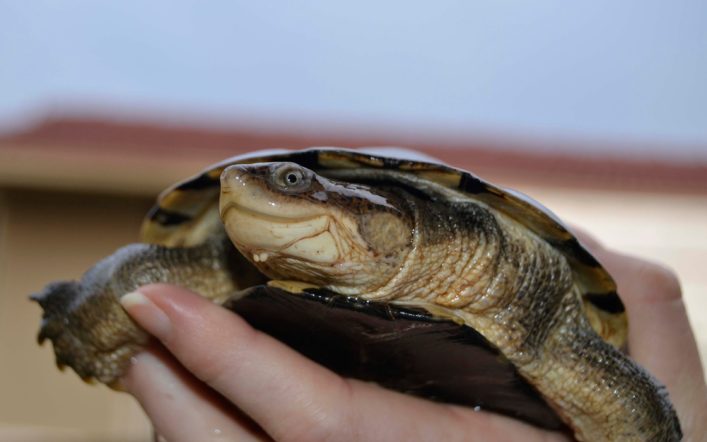Spotting Common Health Issues in Pet Turtles: What to Know

Turtles are generally hardy pets, but like any animal, they can suffer from various health problems. Pet owners must be aware of early warning signs to ensure their turtles remain healthy and thrive in captivity. Early detection of health issues can prevent conditions from worsening and save your pet turtle from unnecessary discomfort.
In this article, we will explore some of the health problems in pet turtles, as well as the steps you can take to prevent and treat these issues.
1. Respiratory Infections
One of the most common health issues affecting pet turtles is respiratory infections. These infections are usually caused by bacteria and are often a result of poor environmental conditions, such as inadequate water temperature or dirty enclosures.
Symptoms of Respiratory Infections:
- Wheezing or gasping for air
- Mucus discharge from the nose or mouth
- Swollen eyes
- Lethargy
- Difficulty swimming or floating unevenly
Prevention and Treatment:
To prevent respiratory infections, ensure your turtle’s habitat is properly maintained. The water should be clean and heated to the appropriate temperature for the species, as turtles are cold-blooded and rely on external heat sources to regulate their body temperature.
If your turtle is showing signs of a respiratory infection, it’s important to seek veterinary care. Treatment often involves antibiotics and adjustments to the turtle’s environment to improve its recovery.
2. Shell Rot
Shell rot is another common issue that can affect both aquatic and terrestrial turtles. This condition occurs when the shell becomes damaged or infected due to bacteria or fungi. Shell rot can develop when a turtle’s shell remains wet for prolonged periods or when it sustains an injury.
Symptoms of Shell Rot:
- Soft, discolored, or pitted areas on the shell
- Foul odor coming from the shell
- Flaky or peeling scutes (the outer plates of the shell)
- Pus or discharge from the affected areas
Prevention and Treatment:
To prevent shell rot, it’s essential to keep the turtle’s enclosure clean and dry. Aquatic turtles need basking areas where they can completely dry off after spending time in the water. Regularly inspect your turtle’s shell for any signs of injury or infection.
If your turtle develops shell rot, prompt treatment is necessary to prevent the infection from spreading. A veterinarian may prescribe antifungal or antibacterial medications and recommend proper cleaning of the shell.
3. Parasites
Internal and external parasites can pose a significant threat to pet turtles. Common internal parasites include worms that can affect a turtle’s digestive system, while external parasites, such as mites and ticks, can infest the turtle’s skin and shell.
Symptoms of Parasite Infestation:
- Weight loss or poor appetite
- Diarrhea or abnormal stools
- Restlessness or excessive scratching
- Visible mites or ticks on the skin or shell
Prevention and Treatment:
Regularly cleaning your turtle’s enclosure and monitoring its diet are key steps to preventing parasite infestations. If your turtle shows signs of parasites, a veterinarian can perform a fecal exam or other diagnostic tests to identify the type of parasite. Treatment may involve deworming medications or topical treatments for external parasites.
4. Vitamin A Deficiency
Vitamin A deficiency is a common issue in pet turtles, especially in species that primarily consume plant-based diets. This deficiency can lead to a range of health problems, including swollen eyes, respiratory issues, and skin disorders.
Symptoms of Vitamin A Deficiency:
- Swollen eyes or eyelids
- Lethargy
- Loss of appetite
- Dry or flaky skin
Prevention and Treatment:
To prevent vitamin A deficiency, ensure your turtle has a balanced diet that includes leafy greens, vegetables, and vitamin supplements if necessary. Turtle pellets that are fortified with vitamins can also help provide the nutrients your turtle needs.
If your turtle is diagnosed with vitamin A deficiency, a veterinarian may recommend dietary changes or vitamin injections to correct the imbalance.
5. Metabolic Bone Disease (MBD)
Metabolic bone disease is a serious condition that affects the skeletal system of turtles. It is caused by a lack of calcium, vitamin D3, or improper exposure to UVB lighting. MBD can lead to weakened bones, deformities, and even death if left untreated.
Symptoms of Metabolic Bone Disease:
- Soft or misshapen shell
- Swollen limbs or jaw
- Lethargy and weakness
- Difficulty walking or moving
Prevention and Treatment:
Preventing MBD involves providing your turtle with a balanced diet rich in calcium and ensuring it has access to adequate UVB lighting. UVB light helps turtles synthesize vitamin D3, which is essential for calcium absorption.
If your turtle is diagnosed with MBD, immediate veterinary intervention is crucial. Treatment typically involves calcium and vitamin D3 supplements, along with adjustments to the turtle’s environment.
6. Abscesses
Abscesses in turtles often occur as a result of bacterial infections, usually around the head, neck, or limbs. These painful lumps can develop due to injuries or poor hygiene in the turtle’s environment.
Symptoms of Abscesses:
- Swollen lumps under the skin
- Discharge or pus from the affected area
- Lethargy
- Reduced appetite
Prevention and Treatment:
Maintaining a clean and hygienic habitat is essential to prevent abscesses. If an abscess develops, a veterinarian may need to drain the abscess and prescribe antibiotics to treat the infection.
Conclusion
Spotting common health issues in pet turtles is crucial to ensuring their long-term health and well-being. By being aware of symptoms and understanding preventive measures, you can provide your turtle with the best care possible. Always monitor your turtle’s environment, diet, and behavior, and consult with a veterinarian if you notice any signs of illness.




